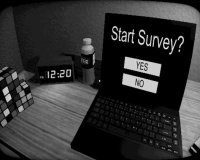
Advertisement
Eyes On The Exam
Eyes On The Exam begins in a classroom that feels both empty and oppressive. You wake up seated at a desk, exam in front of you, surrounded by silent classmates who never move. At the front of the room stands something that looks like a teacher but behaves like a warning. You are expected to finish the test—but the rules are unclear, and the air carries weight. The further into the exam you go, the more it becomes obvious that the danger isn’t in getting a question wrong—it’s in being caught looking for the answer.
Balancing Curiosity and Caution
Each question can be solved, but rarely from your own sheet. The information you need is scattered across the room—on someone else’s paper, scrawled behind a poster, scratched into a desk. Looking is essential. But the more you shift your view, the more you risk drawing attention. The figure at the front doesn’t always react immediately. Sometimes it waits. Sometimes it approaches. The fear builds slowly, not through jump scares, but through the creeping knowledge that you’re being judged for more than your answers.
What Makes Eyes On The Exam Stand Out
- Fully immersive, diegetic interface with no external menus
- Questions that must be answered under time constraints
- A watching figure that reacts to visual behavior
- Secrets hidden in the classroom across multiple sessions
- Multiple outcomes based on awareness and exploration
These elements turn each playthrough into a strategic routine of observation, hesitation, and silent panic.
Each Attempt Adds a Piece to the Puzzle
At first, it feels like just another horror game about avoiding detection. But Eyes On The Exam goes further. On your second, third, or tenth attempt, you start noticing things you missed. The classroom isn’t just a place—it’s a system of rules and consequences, and some of those rules are broken. Papers begin to change. Desks rearrange. The teacher watches longer. There are notes left behind by someone who failed before you, and if you read them closely, they hint at a story bigger than your own test.
No Instructions, Just Instinct
The game offers no tutorials, no guidance. You learn by failing. You improve by watching more carefully, moving less, breathing slower. The more you try to “win,” the more you start to question whether winning is even possible. Eyes On The Exam doesn’t offer escape in the traditional sense—it gives you a cycle to break. But to do that, you need to stop thinking like a student and start acting like someone who knows they’re being watched. Because in this classroom, the exam isn’t what matters. It’s what’s behind it that changes everything.
















































































